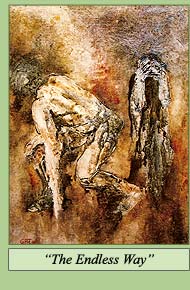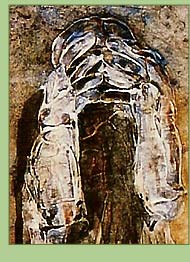 Gerda Tabor - Pescosta is a contemporary Austrian artist. Her works of the past five years are particularly interesting seeing that she achieved a breakthrough in her artistic development at the beginning of this period. The main theme of this time has been the exploration of her subconscious searching for her nature, her origin. A semiotic-semantic analysis of the first painting of this period, The Endless Way, is able to reveal this underlying theme which accompanied, followed and perhaps led to her artistic breakthrough. The first two paragraphs of the following analysis deal with the meaning of the three signs of the painting, the two figures and the surrounding structure. The number of the signs has been rigorously restricted by the artist in order to avoid overstimulation common in everyday life. The paragraphs three and four are devoted to the meaning of the relations of the signs with each other. Gerda Tabor - Pescosta is a contemporary Austrian artist. Her works of the past five years are particularly interesting seeing that she achieved a breakthrough in her artistic development at the beginning of this period. The main theme of this time has been the exploration of her subconscious searching for her nature, her origin. A semiotic-semantic analysis of the first painting of this period, The Endless Way, is able to reveal this underlying theme which accompanied, followed and perhaps led to her artistic breakthrough. The first two paragraphs of the following analysis deal with the meaning of the three signs of the painting, the two figures and the surrounding structure. The number of the signs has been rigorously restricted by the artist in order to avoid overstimulation common in everyday life. The paragraphs three and four are devoted to the meaning of the relations of the signs with each other.
Both figures can be considered as symbols. The left one refers to the search of humans for their origin and their nature, the right one symbolises pain and grief. The left figure is nude and in the main its anatomy is precisely elaborated. The figure bows down and seeks for a connection to the ground with its left arm. Nudity and connection to the earth can be associated with humans searching for their origin, their nature. The body of the right figure is worked out only fragmentarily. The proportionally oversized hands are to the fore. The figure holds its big hands before its face in a gesture of pain and grief. The figure stands frontally to the viewers of the painting and tells them directly about its pain. Both figures are strongly abstracted with regard to form and colour. On the one hand, the high degree of abstraction heightens the aesthetic expression of the figures, on the other hand, abstraction reflects the turning away from corporeality, from materialism and the turning to the mind, to immaterialism. Furthermore, the destruction of corporeality by archaic structures indicates that the two figures are not to be understood as iconic signs representing real objects but as symbols for the metaphysical.
 Considered as a sign, also the structure, by which the two figures are surrounded, symbolises the turning to the subconscious, to immaterialism. The structure is a merging, cloud-like space without a perspective centre. Three-dimensional impressions develop from several overlapping transparent and opaque coats as well as from chiaroscuro-contrasts. The figures are not surrounded by emptiness – emptiness in the materialistic sense of the duality of matter and empty space – but by a structure in the impressionistic sense, a momentary cross-section through the movement in space. Thus, the figures cannot be related to materialist things. The artist conveys an immaterial consciousness of space. The space of the painting represents only a part of the unlimited spatial continuum. If the viewer of the painting permits involvement in this kind of spatial consciousness, the space of the painting merges into the real space in the viewer’s mind’s eye. Also from a sigmatic point of view the structure can be defined as an expression of the subconscious since the process of its creation is based on the principle of intended chance. However, not only the single sub-signs, the two figures and the immaterial, spatial structure, communicate information but also the relation between these signs is of significance. There are two different kinds of the relation between the figures and the immaterial structure. Whereas there is no semantic connection between the right figure and the structure, the connection between the left figure and the structure is meaningful in the true sense of the word. It represents the humans` search for their origin in the sphere of the immaterial, the subconscious. This insight is founded on a syntactic analysis of the form, in particular the contour of the left figure. In the main, the left figure stands out sharply against its surrounding. Nevertheless, meaningful parts of it like the head and the left arm blend with the immaterial structure. Moreover, the figure and its surrounding are matched up for colour. Whereas the left figure is linked with the structure reflecting the subconscious, the right figure seems to be far more independent. There is no specific relation between the figure and the structure seeing that it turns up again and again in the paintings of the artist symbolising pain and sorrow. Considered as a sign, also the structure, by which the two figures are surrounded, symbolises the turning to the subconscious, to immaterialism. The structure is a merging, cloud-like space without a perspective centre. Three-dimensional impressions develop from several overlapping transparent and opaque coats as well as from chiaroscuro-contrasts. The figures are not surrounded by emptiness – emptiness in the materialistic sense of the duality of matter and empty space – but by a structure in the impressionistic sense, a momentary cross-section through the movement in space. Thus, the figures cannot be related to materialist things. The artist conveys an immaterial consciousness of space. The space of the painting represents only a part of the unlimited spatial continuum. If the viewer of the painting permits involvement in this kind of spatial consciousness, the space of the painting merges into the real space in the viewer’s mind’s eye. Also from a sigmatic point of view the structure can be defined as an expression of the subconscious since the process of its creation is based on the principle of intended chance. However, not only the single sub-signs, the two figures and the immaterial, spatial structure, communicate information but also the relation between these signs is of significance. There are two different kinds of the relation between the figures and the immaterial structure. Whereas there is no semantic connection between the right figure and the structure, the connection between the left figure and the structure is meaningful in the true sense of the word. It represents the humans` search for their origin in the sphere of the immaterial, the subconscious. This insight is founded on a syntactic analysis of the form, in particular the contour of the left figure. In the main, the left figure stands out sharply against its surrounding. Nevertheless, meaningful parts of it like the head and the left arm blend with the immaterial structure. Moreover, the figure and its surrounding are matched up for colour. Whereas the left figure is linked with the structure reflecting the subconscious, the right figure seems to be far more independent. There is no specific relation between the figure and the structure seeing that it turns up again and again in the paintings of the artist symbolising pain and sorrow.
 The relation between the two figures summarises the theme of the painting, the turning away from pain and the turning towards the artistic exploration of the subconscious searching for her origin, her nature. At first sight it seems that the sign representing the search for her nature in her subconscious has only little in common with the sign for pain. To be able to elucidate this relation, the biographical context, the life of the artist has to be consulted. Through a bad accident in the year 1995 Pescosta realised how important it is for her to explore her nature. Correspondingly the light, left figure turns away from the symbol for pain and bows down to the earth, which stands for the subconscious, beginning her search. This beginning corresponds with the genesis of the artist’s works of art because The Endless Way is the first of a series of similar paintings which can be read like the results of an artistic exploration of the subconscious. The dark right figure stands for the physical pain owing to her accident as well as for transitoriness of which the artist became painfully aware. The relation between the two figures summarises the theme of the painting, the turning away from pain and the turning towards the artistic exploration of the subconscious searching for her origin, her nature. At first sight it seems that the sign representing the search for her nature in her subconscious has only little in common with the sign for pain. To be able to elucidate this relation, the biographical context, the life of the artist has to be consulted. Through a bad accident in the year 1995 Pescosta realised how important it is for her to explore her nature. Correspondingly the light, left figure turns away from the symbol for pain and bows down to the earth, which stands for the subconscious, beginning her search. This beginning corresponds with the genesis of the artist’s works of art because The Endless Way is the first of a series of similar paintings which can be read like the results of an artistic exploration of the subconscious. The dark right figure stands for the physical pain owing to her accident as well as for transitoriness of which the artist became painfully aware.
A semiotic analysis of The Endless Way shows that Pescosta`s paintings of the second half of the nineties are very personal, nearly intimate since they reflect the exploration of her mind, her subconscious. Nevertheless, the viewers of the paintings play an important role in her artistic intentions. She supports the immersion in the contemplation of her works of art by a brilliant use of aesthetic means. If the viewers permit their being involved in her paintings, Pescosta is able to start a discussion of fundamental human experiences. |